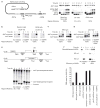DNA end resection, homologous recombination and DNA damage checkpoint activation require CDK1
- PMID: 15496928
- PMCID: PMC4493751
- DOI: 10.1038/nature02964
DNA end resection, homologous recombination and DNA damage checkpoint activation require CDK1
Abstract
A single double-strand break (DSB) induced by HO endonuclease triggers both repair by homologous recombination and activation of the Mec1-dependent DNA damage checkpoint in budding yeast. Here we report that DNA damage checkpoint activation by a DSB requires the cyclin-dependent kinase CDK1 (Cdc28) in budding yeast. CDK1 is also required for DSB-induced homologous recombination at any cell cycle stage. Inhibition of homologous recombination by using an analogue-sensitive CDK1 protein results in a compensatory increase in non-homologous end joining. CDK1 is required for efficient 5' to 3' resection of DSB ends and for the recruitment of both the single-stranded DNA-binding complex, RPA, and the Rad51 recombination protein. In contrast, Mre11 protein, part of the MRX complex, accumulates at unresected DSB ends. CDK1 is not required when the DNA damage checkpoint is initiated by lesions that are processed by nucleotide excision repair. Maintenance of the DSB-induced checkpoint requires continuing CDK1 activity that ensures continuing end resection. CDK1 is also important for a later step in homologous recombination, after strand invasion and before the initiation of new DNA synthesis.
Conflict of interest statement
Figures





References
-
- Lee SE, et al. Saccharomyces Ku70, Mre11/Rad50 and RPA proteins regulate adaptation to G2/M arrest DNA damage. Cell. 1998;94:399–409. - PubMed
-
- Toczyski DP, Galgoczy DJ, Hartwell LH. CDC5 and CKII control adaptation to the yeast DNA damage checkpoint. Cell. 1997;90:1097–1106. - PubMed
-
- Pellicioli A, Lee SE, Lucca C, Foiani M, Haber JE. Regulation of Saccharomyces Rad53 checkpoint kinase during adaptation from G2/M arrest. Mol Cell. 2001;7:293–300. - PubMed
-
- Sugawara N, Wang X, Haber JE. In vivo roles of Rad52, Rad54, and Rad55 proteins in Rad51-mediated recombination. Mol Cell. 2003;12:209–219. - PubMed
-
- Vaze MB, et al. Recovery from checkpoint-mediated arrest after repair of a double-strand break requires Srs2 helicase. Mol Cell. 2002;10:373–385. - PubMed
Publication types
MeSH terms
Substances
Grants and funding
LinkOut - more resources
Full Text Sources
Other Literature Sources
Molecular Biology Databases
Research Materials
Miscellaneous

